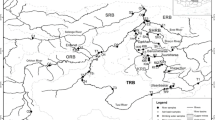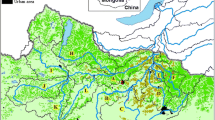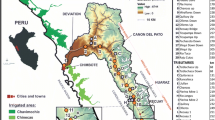Abstract
This paper presents the results of novel field campaigns in the extensive (447,000 km2) Selenga River basin, through which 304 samples of river water and 308 samples of suspended matter were collected during high and low water periods between 2011 and 2013. The Selenga River is the largest tributary (more than 50% of the inflow) to the Lake Baikal. Due to ongoing hydroclimatic change and human pressures under conditions of economic growth, the rivers of the area experience significant change in water quality. A key issue for improved understanding of regional impacts of the environmental change is to disentangle the influence of climate change from that of other pressures within the catchment. Our research aims to evaluate the pathways and mass flows of heavy metals and metalloids both in dissolved and suspended forms, taking a basin-scale perspective that previously has not been fully pursued in the Lake Baikal region. Results showed quality deterioration over short distances due to strong impact of hot spots from urban and industrial activities, including mining. The determined enrichment of dissolved metals in waters of Selenga River as well as the spatial and temporal variability of water and suspended sediment composition is further analyzed in the context of climatic, hydrological and land use drivers.






Similar content being viewed by others
References
98/83/EC (1998) Council Directive (98/83/EC) of 3 November 1998 relating to the quality of water intended for human consumption. Off J Eur Communities L330:32–54
Asselman NE (1999) Suspended sediment dynamics in a large drainage basin: the River Rhine. Hydrol Process 13(10):1437–1450
Audry S, Schäfer J, Blanc G, Bossy C, Lavaux G (2004) Anthropogenic components of heavy metal (Cd, Zn, Cu, Pb) budgets in the Lot-Garonne fluvial system (France). Appl Geochem 19(5):769–786
Bereznykh T, Marchenko O, Abasov N, Mordvinov V (2012) Changes in the summertime atmospheric circulation over East Asia and formation of long-lasting low-water periods within the Selenga river basin. Geogr Nat Resour 3:61–68
Byambaa B, Todo Y (2011) Technological impact of placer gold mine on water quality: case of Tuul river valley in the Zaamar Goldfield, Mongolia. World Acad Sci Eng Technol 51:168
Chalov SR, Zavadsky AS, Belozerova EV, Bulacheva MP, Jarsjö J, Thorslund J, Yamkhin J (2012) Suspended and dissolved matter fluxes in the upper Selenga River Basin. Geogr Environ Sustain 02(05):78–94
Chalov S, Lychagin M, Kasimov N, Belozerova K, Shinkareva G, Romanchenko A, Khristoforov A (2013) Water Resources assessment of the Selenga–Baikal river system. Geo-Öko 34(70):77–102 (Special Issue “Central Asian Ecosystems under Water Scarcity”)
Chalov S, Thorslund J, Kasimov NS, Nittrouer J, Iliyecheva E, Pietron J, Shinkareva G, Lychagin M, Aybullatov D, Kositky A, Tarasov M, Akhtman Y, Garmaev E, Karthe D, Jarsjö J (2016) The Selenga River delta: a geochemical barrier protecting Lake Baikal waters. Reg Environ Change. doi:10.1007/s10113-016-0996-1
Chebykin EP, Goldberg EL, Kulikova NS (2010) Elemental composition of suspended particles from the surface waters of Lake Baikal in the zone affected by the Selenga River. Russ Geol Geophys 51(10):1126–1132 (in Russian)
Gaillardet J, Viers J, Dupre B (2004) Trace elements in river waters. In: Holland HD, Turekian KK (eds) Treatise on geochemistry, vol 5. Elsevier, Amsterdam, pp 225–272
Garmaev EJ (2010) Outflow of the rivers of the Lake Baikal basin. Buryat State University, Ulan-Ude, p 269 (in Russian)
Garmaev EJ, Khristoforov AV (2010) Water resources of the rivers of the Lake Baikal basin: basics of their use and protection. Academic Press “Geo”, Novosibirsk (in Russian)
Gellis AC (2013) Factors influencing storm-generated suspended-sediment concentrations and loads in four basins of contrasting land use, humid-tropical Puerto Rico. Catena 104:39–57
GN 2.1.5.1315 03 (2003) Maximum permissible concentrations (MPC) of chemical substances in water bodies for drinking and municipal needs. Russian Federation Ministry of Health, Moscow (in Russian)
Gordeev VV (2012) Geochemistry of the river–sea system. IP Matushkina II, Moscow (in Russian)
Hayford B, Gelhaus J (2010) The relationship between grazing, erosion and adult aquatic insects in streams in Mongolia. Mong J Biol Sci 8(1):27–39
Heim B, Oberhaensli H, Fietz S, Kaufmann H (2005) Variation in Lake Baikal’s phytoplankton distribution and fluvial input assessed by SeaWiFS satellite data. Glob Planet Change 46:9–27. doi:10.1016/j.gloplacha.2004.11.011
Hofmann J, Karthe D, Ibisch R, Schäffer M, Kaus A, Avlyush S, Heldt S (2015) Initial characterization and water quality assessment of stream landscapes in Northern Mongolia and its integration into a river basin management plan. Water 7(7):3166–3205. doi:10.3390/w7073166
Horowitz AJ, Stephens VC (2008) The effects of land use on fluvial sediment chemistry for the conterminous U.S.—results from the first cycle of the NAWQA Program: trace and major elements, phosphorus, carbon, and sulfur. Sci Total Environ 400:290–314
Hu Z, Gao S (2008) Upper crustal abundances of trace elements: a revision and update. Chem Geol 253(3–4):205–221
Inam E, Khantotong S, Kim KW, Tumendemberel B, Erdenetsetseg S, Puntsag T (2011) Geochemical distribution of trace element concentrations in the vicinity of Boroo gold mine, Selenge Province, Mongolia. Environ Geochem Health 33:57–69
Jarsjö J, Chalov SR, Pietroń J, Alekseenko AV, Thorslund J (2016) Patterns of soil contamination, erosion, and river loading of metals in a gold mining region of Northern Mongolia. Reg Environ Change (in review)
Karaushev AV (1977) Theory and methods of river sediments calculation. Leningrad, Hydrometeoizdat: 272 (in Russian)
Karthe D, Kasimov N, Chalov S, Shinkareva G, Malsy M, Menzel L, Theuring P, Hartwig M, Schweitzer C, Hofmann J, Priess J, Lychagin M (2014) Integrating multi-scale data for the assessment of water availability and quality in the Kharaa–Orkhon–Selenga River System. Geogr Environ Sustain 3(7):65–86
Kaus A, Schäffer M, Karthe D, Büttner O, von Tümpling W, Borchardt D (2016) Regional patterns of heavy metal concentrations in water, sediment and five consumed fish species of the Kharaa River basin, Mongolia. Reg Environ Change (accepted)
Komov VT, Pronin NM, Mendsaikhan B (2014) Mercury content in muscles of fish of the Selenga River and lakes of its basin (Russia). Inland Water Biol 7(2):178–184. doi:10.1134/S1995082914020059
Korytny LM, Bazhenova OI, Martianova GN, Ilycheva EA (2003) The influence of climatic change and human activity on erosion processes in sub-arid watersheds in southern East Siberia. Hydrol Process 17:3181–3193
Kosheleva N, Kasimov N, Gunin P, Bazha S, Enkh-Amgalan S, Sorokina O, Timofeev I, Alekseenko A, Kisselyova T (2015) Hotspot pollution assessment: cities of the Selenga River basin. In: Karthe D, Chalov S, Kasimov N, Kappas M (eds) Water and environment in the Selenga–Baikal basin: International Research Cooperation for an Ecoregion of Global Relevance. ibidem-Verlag, Stuttgart, pp 119–136
Lisitsyn AP, Gordeyev VV (1974) The chemical composition of the suspended matter and water of the seas and oceans. Lithol Min Resour 3:38–57 (in Russian)
Lychagin M, Tkachenko A, Kasimov N, Kroonenberg S (2015) Heavy metals in the water, plants, and bottom sediments of the Volga river mouth area. J Coastal Res 31(4):859–868
Maasri A, Gelhaus J (2012) Stream invertebrate communities of Mongolia: current structure and expected changes due to climate change. Aquat Biosyst 8:18. doi:10.1186/2046-9063-8-18
Martin JM, Maybeck M (1979) Elemental mass-balance of material carried by world major rivers. Mar Chem 7:173–206
MCA (2011) Midterm report, Annex 4. Chapter 5.3 Water quality. http://en.mca.mn/file/545.shtml
McIntyre N, Bulovic N, Cane I, McKenna P (2016) A multi-disciplinary approach to understanding the impacts of mines on traditional uses of water in Northern Mongolia. Sci Total Environ 557–558:404–414. doi:10.1016/j.scitotenv.2016.03.092
Ollivier P, Radakovitch O, Hamelin B (2011) Major and trace element partition and fluxes in the Rhône River. Chem Geol 285(1–4):15–31
Onda Y, Kato H, Tanaka Y (2007) Analysis of runoff generation and soil erosion processes by using environmental radionuclides in semiarid areas of Mongolia. J Hydrol 333(1):124–132
Perelman A, Kasimov N (1999) Landscape Geochemistry. Astreya-2000, Moscow, p 768 (in Russian)
Pietroń J, Jarsjö J, Romanchenko AO, Chalov SR (2015) Model analyses of the contribution of in-channel processes to sediment concentration hysteresis loops. J Hydrol 527:576–589
Roussiez V, Probst A, Probst J-L (2013) Significance of floods in metal dynamics and export in a small agricultural catchment. J Hydrol. doi:10.1016/j.jhydrol.2013.06.013
Rudnick RL, Gao S (2003) Composition of the continental crust. In: Rudnick RL, Holland HD, Turekian KK (eds) The Treatise on geochemistry, vol 3. Elsevier, pp 1–64
Saet YuE, Revich BA, Yanin EP (1990) Environmental geochemistry. Nedra, Moscow, p 335
Savenko VS (2006) Chemical composition of suspended matter in World’s rivers. GEOS, Moscow, p 174 (in Russian)
StatSoft (2008) STATISTICA: [data analysis software system], version 8.0 for Windows update. StatSoft, Inc
Theuring P, Rode M, Behrens S, Kirchner G, Jha A (2014) Identification of fluvial sediment sources in a meso-scale catchment, Northern Mongolia. Hydrol Process 27(6):845–856. doi:10.1002/hyp.9684
Thorslund J, Jarsjö J, Chalov SR, Belozerova EV (2012) Gold mining impact on riverine heavy metal transport in a sparsely monitored region: the upper Lake Baikal Basin case. J Environ Monit 14(10):2780–2792
Thorslund J, Jarsjö J, Wällstedt T, Mörth CM, Lychagin MY, Chalov SR (2016) Speciation and hydrological transport of metals in non-acidic river systems of the Lake Baikal basin: field data and model predictions. Reg Environ Change. doi:10.1007/s10113-016-0982-7
Törnqvist R, Jarsjö J, Pietron J, Bring A, Rogberg P, Asokan SM, Destouni G (2014) Evolution of the hydro-climate system in the Lake Baikal basin. J Hydrol 519:1953–1962
Unger-Shayesteh K, Vorogushyn S, Farinotti D, Gafurov A, Duethmann D, Mandychev A, Merz B (2013) What do we know about past changes in the water cycle of Central Asian headwaters? A review. Glob Planet Change 110(Part A):4–25
Wedepohl HK (1995) The composition of the continental crust. Geochim Cosmochim Acta 7(59):1217–1232
Acknowledgements
Field data and chemical analyses were obtained in frames of the Russian Geographical Society project “Complex Expedition Selenga-Baikal” and a number of Russian Fund for Basic Research projects. It was furthermore enabled by funding from the EU 7th framework programme Marie Curie Action–International Research Staff Exchange Scheme “FLUMEN” (Grant Agreement Number: PIRSES-GA-2012-318969) and the Swedish Research Council Formas (project 2012-790). Authors express special thanks to the Baikal Institute for Nature Management of SB RAS and Joint Russian-Mongolian Complex Biological Expedition for assistance in the implementation of fieldwork. Data analysis and interpretation were done in the frame of the Russian Science Foundation project No 14-27-00083.
Author information
Authors and Affiliations
Corresponding author
Additional information
This article is part of a Topical Collection in Environmental Earth Sciences on “Water in Central Asia”, guest edited by Daniel Karthe, Iskandar Abdullaev, Bazartseren Boldgiv, Dietrich Borchardt, Sergey Chalov, Jerker Jarsjö, Lanhai Li and Jeff Nittrouer.
Electronic supplementary material
Below is the link to the electronic supplementary material.
Rights and permissions
About this article
Cite this article
Lychagin, M., Chalov, S., Kasimov, N. et al. Surface water pathways and fluxes of metals under changing environmental conditions and human interventions in the Selenga River system. Environ Earth Sci 76, 1 (2017). https://doi.org/10.1007/s12665-016-6304-z
Received:
Accepted:
Published:
DOI: https://doi.org/10.1007/s12665-016-6304-z




